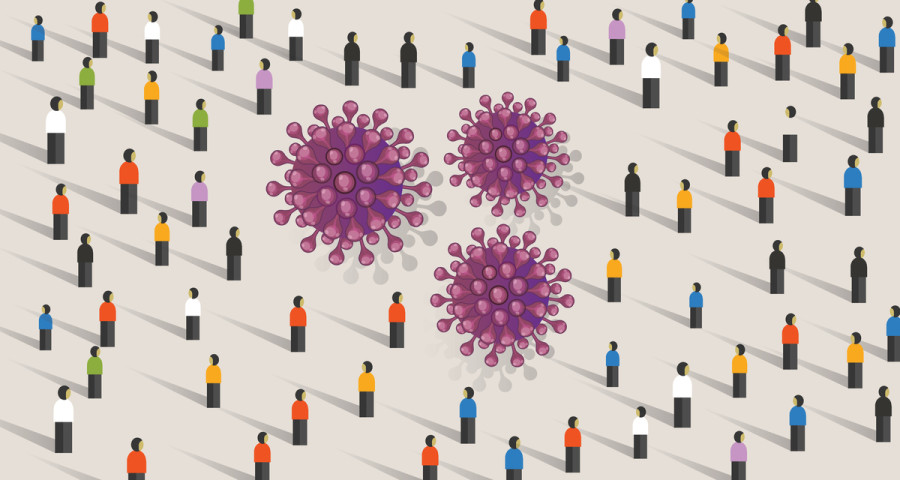Columns
Covid-19: A scientific perspective
There seems to be a misconception that lockdown measures alone will tackle the novel coronavirus. This is far from the truth.
Sameer M Dixit
Ever since the first case of the novel coronavirus (subsequently renamed SARS-CoV-2) in humans was reported by authorities in China, its spread has been continuous. Beginning in Wuhan, then moving to parts of Italy before spreading to the rest of Europe, then spreading to the United States (now the hotspot), Covid-19 has become the next big pandemic after the 2009 outbreak of the Swine flu (novel influenza A/H1N1). Interestingly, high-income countries appear to have been the most affected by this pandemic. Europe and the US account of 70 percent of total deaths caused by Covid-19 to date. An accurate number of the infected is hard to calculate, since not all countries are testing their population the same way and in the same numbers. But Africa and Asia (including China) have reported less than 10 percent of global deaths. Cases in India are increasing, but the mortality numbers are much lower than in high-income countries. South America also has not been as severely affected, with just over 5 percent of global mortality. In the South Asian region, Covid-19 cases are on an increasing trend. Yet, for a region with very high population density, further aggravated by low economic status, the severity of the disease, and the death rate, so far appear low.
Research is required
Nepal reported its first Covid-19 case in January this year and the second case was reported after two months, in March. New cases have been detected regularly since the number of diagnostic tests increased somewhat from March. Yet, the point of interest is the marked absence of severe cases. To date, only two people in Nepal have succumbed to the disease. If we are to follow the global statistics, up to 20 percent of the infected population (in the higher age group and those with other co-morbidities) should have severe symptoms. Even if we assume that there are many more Covid-19 cases in Nepal that have escaped detection due to a lack of enough testing, the current situation—of the low number of severe cases—makes us wonder why. Well-planned research is the way forward, and for that, the government needs to work closely with like-minded and knowledgeable individuals. There are some theories that might help guide our research.
Nepal has a relatively young population. According to national census data from 2011, the median age is approximately 22 years, with 95 percent population under the age of 65. Global data for Covid-19 has shown that people over 70 years are affected much more than those younger. In Nepal, the percentage of the population over the age of 70 is 3 percent and those over 80, around 0.8 percent. Compare this to Italy, where the median age is 46 years, with over 20 percent of the population aged 65 or over, and it might show why they were hit hard by the pandemic. Further, there is scientific literature that suggests BCG vaccination may play a role in reducing the severity of infections in populations that have this vaccine in their routine immunisation programmes. While outliers exist, the data supporting this observation is substantial. Nepal (and many other developing countries) has been implementing this vaccine for preventing tuberculosis for about 50 years. Furthermore, exposure to various pathogens when young has been linked to strengthened immunity. Could this be a factor for reduced severity in the Nepali population? Lastly, the novel coronavirus, like many other viruses, mutates regularly. The question arises whether the virus strain floating around the country has undergone a mutation, allowing it to stay within the body for a long time but without causing severe symptoms like what has been seen in affected countries.
Nepal’s approach to Covid-19
Nepal’s response measures are a much-discussed topic on social media. One group thinks that we have yet to see the true impact of the virus, as it is just emerging in India from where it will trickle into Nepali districts. An opposing thought is that since it’s been over six months since the start of the pandemic, and Nepal well-connected with China and India, the infection could have been in the population for a very long time and we may be identifying the later stages of a pandemic. Both of these ideas make sense, depending on how one looks at the situation. Regardless, the dilemma the Nepal government faces is how to move forward.
The World Health Organisation has outlined requirements to ease the lockdowns in countries. However, to attain those requirements, it would take months, if not years. Therefore, each country has to make its own assessment so that its population is least affected. The same solution will not fit all regions. The need for a catered response is all the more true for low-income countries. Pakistan and India, two of the most populated countries in South Asia, have seen a sharp increase in Covid-19 cases and mortality in the last few weeks, but have started easing lockdown restrictions. In fact, Pakistan has eased the lockdown in a major way while cases continue to rise. Nepal has also eased restrictions somewhat, yet those appear only on paper and not observed in implementation with complete lack of clarity. There appears to be a misunderstanding in the population as well as within the government that lockdowns alone will solve the problem of Covid-19. This couldn’t be further from the truth. The lockdown is just a temporary solution. If implemented strictly for a long time, lockdown will only lead to other, more serious issues in the population.
There has been a sharp rise in cases of suicide around the country during the lockdown. Violence (sexual and otherwise) against women is on the rise. Mental health cases have been reported to be on the rise, too. Five districts recently reported an outbreak of measles, while the national immunisation programme has been severely affected. The season for vector-borne and food or water-borne diseases is upon us, yet health services are focused solely on Covid-19. Dengue, scrub typhus, and diarrheal diseases are endemic to Nepal, and are likely to cause death in the vulnerable population in the absence of services. Maternal mortality at childbirth, especially during home births, in remote parts of Nepal is likely to increase due to lockdown. Similarly, lifesaving medications for major non-communicable diseases such as diabetes, kidney diseases, cancer among others are already hard to access for the majority of the population in Nepal, as lockdown affects transport and health services. Covid-19 is capable of causing death, but a long term lockdown will lead to far more death and disability in the Nepali population.
We need to accept that Covid-19 will continue, both globally as well as in Nepal, for a long time. We need to continue to monitor the situation, carry on with contact tracing, maintain strict health measures while at the same time gradually easing off lockdown measures. We have to ultimately face the virus, learn to live with it, while taking special precautions for the elderly, those with other diseases and pregnant women. An extended lockdown is not the ultimate solution.
***
What do you think?
Dear reader, we’d like to hear from you. We regularly publish letters to the editor on contemporary issues or direct responses to something the Post has recently published. Please send your letters to [email protected] with "Letter to the Editor" in the subject line. Please include your name, location, and a contact address so one of our editors can reach out to you.




 9.12°C Kathmandu
9.12°C Kathmandu















